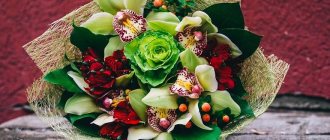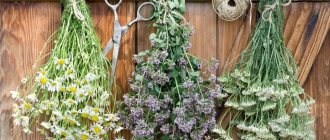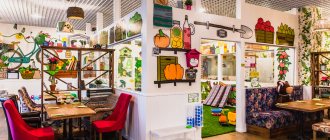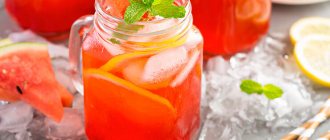How indoor flowers can survive your vacation, how to preserve them during departure
How to Preserve Flowers While on Vacation
You love indoor plants. But sometimes you have to go somewhere, for example, on vacation. How to preserve flowers during your absence? After all, you can’t leave them to the mercy of fate. Why not go anywhere because of flowers? This is what we will talk about.
Even if you are not going on vacation, you may always need to go, for example, to visit relatives or on a business trip. And what if everything “grown by back-breaking labor” goes to waste? Oh no! . If there are no relatives or neighbors to whom you can entrust watering the plants, describing how, when and how much to water, then it doesn’t matter. Vacation and flowers are compatible things. There are various options for preserving flowers during your absence.
The period of your departure is up to 7 days, unless the weather is very hot, the majority of indoor plants can survive without any special equipment, here we are not talking, of course, about very delicate and moisture-loving plants. And if these are cacti and aloe, then they will easily tolerate a two-week lack of watering.
If you are away for a week and the weather is hot, you can cover the pot along with the surface of the earth in a plastic bag or put wet moss, felt cloth, or even just a piece of oilcloth on the surface of the earth, after watering the plants well. During your absence, it is better to remove plants from the windows, especially if they are south-facing windows.
For large flowers, you can organize drip watering from a small hole in the cork of a plastic bottle made with a thick needle. The bottle is placed vertically, with the cork down on the surface of the earth, you can deepen it a little. You also need to make a hole in the top of the inverted bottle (what used to be its bottom). To maintain the position of the bottle and give it stability, it must be tied to some support. How quickly water will flow out of the bottom hole depends on the size of the hole. This is determined practically in advance.
If you will not be at home for 10-12 days, then the most common way to water the plants will be to water them from a container with water flowing through strings.
Container with water
We remove the plants from the window; you can arrange them on the floor in a circle. In the middle of the circle we place a container of water, which should be located slightly above the surface of the ground in flower pots.
Watering plants while on vacation
We take a rope or a narrow strip of fabric, one end of which we place in the water, the other on the surface of the plant’s soil. We carry out this procedure with all plants placed around a container of water. Watering of plants is carried out using a wet rope.
As long as there is water in the container, the soil in the pots will be moist, so the container with water should not be too small. The windows should not be left open. And it will be better if you limit the space in which you leave flowers by closing the doors to the room. Plants should not be placed in the bathroom; they still need light.
Plant under a jar
Small plants can be placed under a glass jar. And you don't have to worry about them. The same jar can be used to cover low plants up to the surface of the ground so that there are no gaps between the edge of the jar and the surface of the ground.
Store plants under a plastic jar
Wide plastic jars are available for sale; they can also be used to cover larger plants. Or you can use drinking water bottles. We cut off the top at the level of the tapering neck and cover the plants.
If you are leaving home for 2-3 weeks and there are a lot of plants, then you need to pack them more securely. It is worth stocking up on large-sized plastic film in advance. It is usually sold as a “stocking” 1.5 m wide. For one package you will need 1-1.5 linear meters, depending on the height of indoor flowers.
How to save plants
Small plants can be packed in separate bags. If you put the bag on top, then tie it tightly with a rope at the bottom; rubber bands or tape are also suitable. If you place a plant in a bag, then the top of the bag must be hermetically sealed. Here it’s easier to use paper clips, a stapler, rubber bands, or just tie it with a string.
If there are a lot of plants, then we arrange them close to each other, taking into account that each of them should receive a little light; we put the taller and less light-loving ones in the background. The two or three tallest plants can be placed on the sides, they will hold the top of the film, for me these are usually large ficuses.
When the main part of the plants is assembled, carefully put on the film stocking, straighten the film, lifting it up and secure it with clothespins around the large plants on top.
Flowers during vacation
We also connect the ends of the film at the top with clothespins or paper clips, forming a sealed space under the film where the flowers will live during your absence. It is better to place such a greenhouse away from the window, but it is also possible to place it on a window.
If you placed flowers on a window, then leave a small gap at the top of the film; when the sun is shining, the excess heat will rise up a little.
Flowers under film
Before wrapping indoor plants in plastic, they should be well watered. Under the film you need to place one or two containers with water the size of a glass, then even if it is very hot inside, the humidity will help the flowers survive.
If you grow flowers on special racks, then the principle is the same, you just need much more film. The entire rack is covered with film up to the floor and containers with water are placed inside.
Time-tested home methods of automatic watering
- Sphagnum moss and plastic bag.
Moss, soaked in settled water and spread on the surface of the ground in pots, perfectly retains moisture, gradually releasing it into the soil. A plastic bag placed on top and secured at the bottom of the flowerpot with adhesive tape creates an additional obstacle to the evaporation of moisture. In this mode, the plant can exist without problems for up to 10 days. - Tea bags.
Before leaving, used and pre-dried tea bags are soaked generously with water and the entire surface of the earth in the flowerpot is covered with them. Thanks to the mulch layer, the water-saturated soil will remain moist for a long time, and the microelements of the tea will provide the roots of the flowers with additional nutrition. Immediately upon arrival, the bags are removed and the soil is sprinkled with a thin layer of plant ash to prevent the development of mold and the appearance of pathogens. - Plastic bottles.
Automatic watering is based on the principle of aquaglobes. In a bottle of the required volume, 2 holes are made using a hot awl tip - in the bottom and in the lid. Having poured water into the container, it is immersed in the soil of the flowerpot with the lid down. The roots of the plant absorb water as needed. About 20 days before leaving, you should experiment several times with a homemade device to determine for how long and for which plants 0.5, 1, 1.5 or 2 liters are enough. - Pallets.
Flower pots are placed on pallets, the bottom of which is filled with expanded clay, agroperlite, broken brick, small pebbles or coarse river sand. After abundant watering before leaving for vacation, water flows out of the drainage holes of the flowerpots and fills the pan. This irrigation method is suitable for undemanding crops that do not respond to waterlogging or drying out of the soil mixture. - Wick watering.
Burlap, thick cord or strips of coarse fabric are rolled into a rope, one end of which is placed on the surface of the ground in a pot, and the other is lowered to the bottom of a jar filled with water. It is placed near the plants, at some elevation relative to the level of the window sill. It is imperative to determine in practice how much water enters the soil and what volume of jars to use for the estimated period of time. For moisture-loving flowers, several wicks are used. - Hydrogel.
Granular hydrogel is currently commercially available. Mixed with soil, it is used to replant indoor plants. This material absorbs water, retaining it in its structure, and significantly reduces the rate and frequency of watering.
The problem of watering indoor flowers during the holidays is familiar to many. When you go on vacation with your family, you need to entrust someone with caring for your pets.
It’s good if there is one of your relatives who understands at least something about indoor plants and can water them correctly. Or at least just water it occasionally so that it doesn’t dry out at all.
But almost always, upon returning from a trip, you have to count your losses - this has dried up without water, its roots have rotted from excessive watering, something has been broken, something has been dented.
What if there are no relatives or close friends who are ready to take on the responsible mission of caring for your indoor plants?
If you are leaving for a month or more, then you cannot do without a special automatic watering system.
Now they are sold in any city and consist of a water container of a certain size, a set of thin tubes and a control system that ensures the supply of water from the container at the required intervals. You set how often and in what quantity to water, and you can safely leave. But to avoid unwanted surprises, it’s better to try how it works before your vacation.
And if there is no automatic watering system, then you have to come up with different clever ways to water the plants during vacation.
It should be said that all these cunning methods are good if you are leaving for 1-2 weeks. If it’s more, then how lucky!
There are several ways to provide water to your plants during the holidays.
Method 1. Grandma's old method. Water the plants generously so that the earthen ball is completely saturated with water. Place the pots on trays or in wide basins of water, so that the bottom of the pot is in the water (shallow). It’s even better to pour small pebbles or coarse sand into a tray and place the plants, slightly deeper.
This method of watering during the holidays is suitable for unpretentious plants that tolerate both excess moisture and drying out (chlorophytum, geranium, balsam, chamedorea palm, sansevieria, crassula).
Method 2. Use a plastic bottle. Water the plant well. Take a plastic bottle with a cork, heated in a fire with a thick needle (you can use an awl or a knitting needle) to make 2 holes - one in the cork, the other in the bottom. Pour water into the bottle and secure it with the neck down. Water will constantly flow out drop by drop and moisten the soil. This is better for watering large plants.
Be sure to try this method some time before departure: take several different bottles, punch holes, place the neck down in any tall container (each separately) and see how much water drips from each of them in a day. If you choose the right bottle for each plant, the problem of watering during the holidays will be optimally solved.
Method 3. Wick watering. This is a common method of constant watering for some plants, particularly Saintpaulias (violets). The essence of the method is that the pot with the plant constantly stands on a vessel with water, one end of a synthetic cord is placed in a ring in the soil under the plant, its other end is lowered into a vessel with water through a drainage hole. The cord should absorb water well. Water wets the cord along its entire length, rising from the vessel into the pot and moistening the soil.
This method of watering is suitable for small plants and requires first replanting them in a pot with a wick.
But this method can also be used for temporary watering during the holidays. To do this, take a synthetic cord that absorbs water well or twist a rope from a strip of fabric. One end of it is placed on the surface of the earth in a pot (it is advisable to sprinkle it with a little substrate), and the other is lowered into a bucket of water. It is better to place the bucket above the pot (this way the wicks do not dry out). Typically, plants are placed on the floor and a bucket of water is placed on a stool.
It is important to test this method on each plant in advance. Some plants require several wicks, others only one. This method of watering is good for 10 days of vacation.
The same method is used to moisten a tray with pots placed in sand or peat.
The downside is that sometimes in hot weather the wicks dry out and water does not flow to the plants.
On sale you can find ready-made wick systems for irrigation, consisting of a reservoir of water, a wick and a porous ceramic rod for immersion in the soil
Method 4. Use hydrogel. A hydrogel is a polymer that can absorb water in very large quantities and then slowly release it to plants. It is sold in granules.
The polymer is soft, colorless, it quickly absorbs water and is intended to be added to the soil. Indoor plants planted in a substrate with hydrogel are rarely watered. It’s enough to water the flowers well before going on vacation, and you won’t have to worry about them for a week or even two. And they won’t rot and won’t dry out. The downside is that the plants must be planted in advance in such soil.
You can also use decorative Chinese hydrogel in the form of colored balls. Pre-wet the granules for 6-8 hours. When they swell, pour them into pots on top of the substrate and cover with moss on top. The balls will gradually release moisture into the soil. If the plants have a non-surface root system, then you can mix the top layer of soil with hydrogel beads.
The child was placed with his grandmother, the cat was taken by a cat-loving friend... And the only thing that separates you from the coveted sun lounger on the sea beach is the rows of pots with flowers on the windowsills. It’s as if they are reaching out to you with their leaves and begging: “Don’t leave us alone, we will be lost without you!”
Well, don't unpack your suitcases! You have long dreamed of a vacation and probably deserve it, however, you cannot sacrifice indoor flowers, because each of them contains your work and a part of your soul.
How can you relax peacefully at sea and at the same time not sacrifice your indoor flowers? There is an exit.
How to preserve flowers during the holidays without watering
When planning to leave home for a while, many are tormented by the question of how to preserve flowers during their vacation without watering. If you do not have the opportunity to leave house plants to relatives or friends, or entrust someone with the keys to your apartment while you are away, the tips collected in the article will help solve the problem.
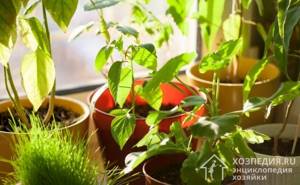
You can preserve homemade flowers in pots during the holidays using two approaches to solving the problem, says hozpedia.ru. If you are leaving for several days (up to two weeks), then you should try to preserve as much as possible the moisture received during the last watering, so to speak, water the flowers “with a reserve.”
Flowers in pots made of natural materials (clay, ceramics) better tolerate the lack of periodic moisture.
If you are away for a longer period of time, you will hardly be able to do without a remote watering system. However, you should not be afraid of the second method. In addition to expensive automatic devices, there are many options for solving the problem using simple improvised means.
No matter how long your vacation or business trip lasts, indoor plants need to be prepared for the lack of usual care. Follow these simple steps:
- if flower pots are on window sills, remove them and place them on the floor;
- create moderate lighting for them (in no case should you completely cover the windows with thick curtains, otherwise the plants may die);
- choose a draft-free room for flowers;
- do not fertilize for at least a week before departure; inspect the stems and leaves for diseases, pests, remove all damaged, infected or simply dried parts;
- cut off overly large leaves, as well as flowers and buds.
Most of the preparatory actions are aimed at “preserving” plants. If the life processes in them are not as active as in normal times, then they will consume less moisture and, accordingly, will more easily tolerate its lack.
Alternative Methods
Of course, you shouldn’t forget about these options: take the flowers to your friends while you’re away or ask someone to come in for watering.
Circumstances may arise when the person to whom you have entrusted the care of your flora wants to play it safe and floods the plants. Not everyone understands that sometimes excess moisture is worse than its lack. You should explain this in detail to your potential assistant, but do not overdo it so as not to frighten the person with responsibility. You can try to find a person who professionally cares for flowers, for example, via the Internet: there are enough offers in this segment of the service industry. Or you can try to negotiate with someone you know, not on a monetary basis, but in exchange for a return favor - to look after the flowers during their vacation.
Video: watering flowers while on vacation We looked at the basic techniques and methods that allow you to water your flower garden while on vacation. If you decide to make the device yourself, let us remind you once again that it is better to test and configure it in advance. If you want to invite an outsider for a responsible procedure, you should once again think about the safety of this method.
agronomu.com
Preparation
You can preserve homemade flowers in pots during the holidays using two approaches to solving the problem. If you are leaving for several days (up to two weeks), then you should try to preserve as much as possible the moisture received during the last watering, so to speak, water the flowers “with a reserve.”
Flowers in pots made of natural materials (clay, ceramics) better tolerate the lack of periodic moisture.
If you are away for a longer period of time, you will hardly be able to do without a remote watering system. However, you should not be afraid of the second method. In addition to expensive automatic devices, there are many options for solving the problem using simple improvised means.
No matter how long your vacation or business trip lasts, indoor plants need to be prepared for the lack of usual care. Follow these simple steps:
- if flower pots are on window sills, remove them and place them on the floor;
- create moderate lighting for them ( in no case should you completely cover the windows with thick curtains, otherwise the plants may die );
- choose a draft-free room for flowers;
- do not fertilize for at least a week before departure;
- inspect the stems and leaves for diseases, pests, remove all damaged, infected or simply dried parts;
- cut off overly large leaves, as well as flowers and buds.
Most of the preparatory actions are aimed at “preserving” plants. If the life processes in them are not as active as in normal times, then they will consume less moisture and, accordingly, will more easily tolerate its lack.
How to help plants survive time without watering?
If the owners are going to be away for a long time in order to preserve indoor flowers, you should pay attention to these simple tips.
- It is better to move pets away from windows. On a windowsill in the summer without water they will suffer from the sun, in the winter from radiators. If the curtains are thick enough, you can simply close them in the warmer months. It is better to rearrange plants located on the south, south-east or south-west window. In the off-season, it is appropriate to turn off the heating or remove flowers away from the heat source.
- Remove inflorescences and buds a few days before departure. There will be no one to admire the beauty, and flower brushes take away a lot of precious moisture from the plant.
- Cover tightly with a transparent jar small flowers that love high humidity and dry out quickly. For larger plants, you can use large plastic bags. Secure the ends with an elastic band so that there are no large gaps. In this case, the moisture will not evaporate quickly.
- Be sure to water the day before or on the day of departure. The flower is not irrigated from above, but bottom watering is used. The plant is placed in a container with water for 10-15 minutes. When the soil is well saturated with water, the flower is taken out and the excess liquid is allowed to drain. Plants watered in this way retain moisture longer.
- Close windows and doors. Place containers of water near the flowers. This will help avoid drafts and maintain moisture near them.
- Do not feed flowers 2-3 weeks before departure. It is completely inappropriate to activate life processes at this time.
- Remove damaged and dry leaves. Check for pests or signs of disease. If necessary, treat the flowers with the necessary preparation, because a plant weakened without water becomes more vulnerable. It is better to do this 1-2 weeks before the trip.
- Place a layer of expanded clay or gravel at the bottom of a large container. Place small pots with moisture-loving plants inside (they are pre-watered). Pour water onto the expanded clay or gravel so that it does not touch the bottom of the flowerpots with pets. Increased humidity will help plants survive the time without watering more easily.
Advice
If you often have to leave your favorite indoor flowers unattended, it is better to plant them in clay pots. Such containers retain moisture better than plastic ones.
Ways to preserve moisture
How to preserve indoor flowers without watering for 2 weeks or a little less? In such cases, they need to be watered abundantly and try to limit the evaporation of moisture .
Gather all the plants in one place, place them fairly close to each other and water well (the soil should be completely moist). The pots can be placed in a container with water and expanded clay or wrapped in damp newspapers and polyethylene on top. This will create an area of high humidity for the flowers. You should not place containers with flowers in water: with constant contact with moisture, the roots quickly rot .
Preparing plants for holidays
There are two weeks left before departure.
Completely stop feeding plants with various additives. This will help your indoor flowers slow down their rapid growth, and, therefore, reduce their appetite and need for your presence.
There are 7-10 days left before departure.
Remove all affected and diseased leaves, shoots, and buds. If necessary, treat sick plants with medicinal preparations, and healthy ones for prevention with herbal infusions.
There are three days left before departure.
Trim buds and flowers without regret. You still won’t be able to admire them, but this will significantly save the plant energy and resources.
On the eve of the trip.
Water and wash each plant, place all flowerpots on the floor, away from the scorching sun. In this case, the “more fun together” rule applies: place the pots as close to each other as possible to maintain air humidity longer. You can build a polyethylene cap on top, but be careful: plants with succulent leaves can rot and become moldy.
Remote watering methods
You can save indoor flowers when going on vacation for a month using a regular plastic bottle . Fill the container with water, close it with a lid, and then make a small hole in it. When turning the bottle upside down, the cap should be moistened. The bottle should be dug in this position into the ground to a depth of approximately 2 cm.
Another method known to many is the use of so-called wick watering . To carry it out, strips of fabric that absorb water well are selected. One end of the “wick” is buried in soil, and the other is lowered into a vessel with water. An important condition is that the container with the liquid must be higher than the pot, then the fabric will supply moisture to the roots without any problems.
Ready-made “wicks” can be found in specialized stores.
For larger plants, one strip of fabric may not be enough. When organizing watering, expect that for a pot 20-30 cm wide you will need 2-3 “wicks”.
A variation of this method is watering through a drainage hole. A string is inserted into the flower pot through the holes, the ends of which are then lowered into a container of water, as shown in the photo below.
Plants in pots with drainage holes can be provided with moisture using a damp cloth . The horizontal surface is covered with film or other material that does not allow water to pass through. It is covered on top with a piece of fabric with good absorbent properties, one end of which is dipped into a container of water. Plants will be able to receive the required amount of moisture through the hole in the pot.
Instead of fabric, you can use a special copillary mat - a mat made of hygroscopic material.
The above methods will preserve the viability of plants for up to one month. If you are away for a longer period of time, it is unlikely that you will be able to do without purchased automatic watering systems . Such devices have a wide price range and a variety of configurations, so everyone can choose an option to suit their taste and budget.
Flowers for vacation - care
Let's consider the option in which it was not possible to find a nanny for your flowers. So, how to provide watering to flowers without your participation? In this case, preventive measures are taken.
Method 1.
All plants in clay pots can be buried shallowly in peat or expanded clay. You can use old basins and even a bathtub for this. Peat or expanded clay should be watered well, and each flower should be watered separately.
Method 2.
Place pots with flowers that are in great need of regular watering in a container with water (basins, bath), but remember that for some flowers, waterlogging is as harmful as drought.
Method 3.
My mother did the following: all the flowers were placed in one place on the floor, between them on a stool my mother placed a large pan of water. Then we cut an ordinary bandage into long strips, each of which was lowered with one end into a pan of water and the other into a pot with a flower. For large flowerpots you need several of these strips.
Method 4.
If there is no one to leave flowers for, my friend does this: she puts a regular dropper in each pot, which are sold in every pharmacy.
Method 5.
The most reliable, but, alas, the most expensive way to preserve flowers during the holidays: buy special containers with an automatic watering system. Another option is capillary mats. These are special mats that work on the principle of the bandage method (see above). By the way, instead of capillary mats, you can use regular felt.
What plants will survive without watering?
There are also such “steadfast tin soldiers”:
- – cacti, aloe, cycads, euphorbia, which can do without watering for up to three weeks;
- – yucca, jatropha, bocarnea, which can easily survive without water for two weeks;
- – amaryllis and begonia, without any problems drinking water for a week.
Caring for flowers after returning
When you, rested and tanned, cross the threshold of your home, provided that before leaving you took advantage of our advice and did everything correctly, you will not face any unpleasant surprises in the form of helpless, dried out and forever destroyed indoor plants.
Inspect each flower, remove dried or rotten elements and saturate the soil in the pots with water using bottom watering. Do not expose plants to light immediately; acclimate them to brighter light gradually.
floristics.info
Quote from Enigmatica's message
How to preserve indoor flowers while going on vacation!
If you are going on vacation and are enjoying the upcoming pleasant days, then your indoor flowers are unlikely to rejoice as much as you, because they will face difficult trials and suffering from thirst! Therefore, take care of their well-being in advance.
Of course, you can ask relatives or neighbors to look after the plants. But what to do if you don’t have any? Then let's resort to an automatic watering system! There are many ways to preserve plants.
But first you should prepare the flowers for your departure:
1. Remove flowers from the windowsill or draw the curtains tighter. The less light, the slower the life processes in plants, which means they will need less moisture.
2. Water the soil well until it is saturated with water. The pot can be wrapped in damp newspaper and cellophane on top. This will reduce moisture loss.
3. Small plants should be covered with plastic or glass caps or bottles, but so that they allow air to pass through from below. Evaporating water will condense on the walls and flow back into the ground.
4. 5-7 days before departure, carefully check whether the plants are affected by pests and diseases. Remove from the plant all dried and disease-damaged shoots and leaves, as well as large buds and flowers. Treat diseased plants with appropriate medications.
5. It is better to cut off overly large leaves.
6. Plants should be placed in a lighted place, but not in the sun.
7. Close both doors and windows so that there are no drafts in the room where the plants will remain.
8. 2-3 weeks before departure, stop all types of feeding.
9. If leaving plants in a tray of water, place the flower pots on a raised rock or wooden stand to keep the roots from freezing.
10. Flowers in ceramic pots tolerate separation better than those in plastic containers.
The simplest and most commonplace ways to maintain soil moisture.
- For plants in clay pots. If you keep indoor plants in clay pots, then each pot can be wrapped in moss - both the moss and the plant will be moisturized abundantly. If there is no moss nearby, place the clay pot in a larger container. Expanded clay should be poured onto the bottom, and the gap between the walls of the container should be filled with the same expanded clay. This will maintain more or less constant soil moisture. The top layer of soil in a pot or container can also be sprinkled with expanded clay; it will prevent drying out.
- This method is effective if the plants are left for 7-10 days.
- Drip irrigation. Take a plastic bottle, depending on the volume of the pot, fill it with water, make a small hole in the cork (with a gypsy hot needle), first water the flowers and stick the bottles into them with the cork down. As the soil dries, the flower will absorb water from the bottle. It’s a good idea to secure it on both sides with sticks (for example, ice cream sticks).
- This dropper lasts 5–7 days. They put several bottles in large flowerpots and the supply will last longer.
Watering through the “wick”. These can be ropes, laces, woolen threads of different diameters, twisted bandages, and so on. One end of the wick must be lowered into a container with water (for example, a basin), and the other end must be placed in a pot (to be secure, it will need to be secured, for example, with a peg). Water will flow to the flowers due to the difference in capillary pressure.
One 10 liter container is enough for 7 days for 6–7 plants
Moisture-loving plants can be placed on pallets, deep trays or in wide basins of water so that the lower part of the pot is in the water. The soil on top is covered with damp moss or expanded clay.
Moisturizing through fabric. Lay an oilcloth film on the kitchen table (you can also place the pots in the bathroom if the plants are not sensitive to light), lay a cloth soaked in water on the oilcloth (cloth, felt, an old baby blanket, batting folded in several layers). Place pots with already watered plants on the fabric; the end of the fabric should be dipped in a container of water. Pots must have drainage holes; saucers are not needed.
This method is suitable for a period of 10-20 days.
Moisture-loving plants can be placed on pallets, deep trays or in wide basins of water so that the lower part of the pot is in the water. The soil on top is covered with damp moss or expanded clay.
Moisturizing through fabric. Lay an oilcloth film on the kitchen table (you can also place the pots in the bathroom if the plants are not sensitive to light), lay a cloth soaked in water on the oilcloth (cloth, felt, an old baby blanket, batting folded in several layers). Place pots with already watered plants on the fabric; the end of the fabric should be dipped in a container of water. Pots must have drainage holes; saucers are not needed.
This method is suitable for a period of 10-20 days.
Water through the “wick” at the bottom of the pot. You will need your flower pot and another container to place under the pot. Make holes in the pot and thread the string as shown in the picture. Place the pot on a vessel with water so that the end of the rope falls into the water. The water will rise up the rope and moisten the ground.
For a pot with a diameter of 10 cm, one wick is enough, and for a pot with a diameter of 25-30 cm, 3-4 wicks are needed for an adequate supply of water.
Today, all sorts of “soil moistening” systems work on almost the same principle.
Let's say Archimedes system , which consists of a glass flask - a water tank - and a ceramic cone, which is immersed in the ground. Water trickles through the capillary-porous ceramic walls drop by drop and constantly moistens the soil. You will have to put several of them in a balcony box or large pot, of course. By the way, it looks very nice! From an aesthetic point of view, this is perhaps the most glorious option. They cost about 180 rubles per piece. A cone in a flower pot lasts for 5-7 days
Or here are Blumat cones , but in addition to the cone, you also need some kind of remote container with water. The cone itself is placed in a pot, and the tip of the hose with a weighting agent is lowered into a container of water. These devices draw water “on demand”—as the soil in the pot dries out, the cone gradually releases water to the surrounding soil. The inconvenience is that the water container should be higher or at least on the same level as the pots. You won’t always fit in, to be honest. Well, the price is not very encouraging - about 4 thousand for 25 cones.
Automatic watering systems. Remember that all of the above methods are designed for a maximum of three to four weeks of your absence. If you have to leave for a longer period of time, you won’t be able to do without complex store-bought automatic watering systems.
The most popular thing is Gardena , which is capable of watering, as the manufacturer writes, up to 36 plants at the same time. Sold in OBI and other large shopping centers. The kit includes a pump with a filter, a transformer with a timer to power the pump, a supply hose, three distributors (each with 12 outlets), a capillary hose, holder pegs, end plugs and a plastic water container for 9 liters.
One or more branches can be connected to each plant; you will have to find out the required number experimentally. If, for example, 60 ml of water per day is not enough for plants in a large container (and that is how much can flow out in a minute), the amount of moisture supplied will have to be increased by installing additional capillary tubes. The hose is attached to the pump, the pump is immersed in the tank indicated above, and the system begins to operate. If the water in the tank suddenly runs out, the pump will turn off automatically, and when water is added, it will continue to function. Inconvenience - you need an outlet to which the system will be connected. Costs from 3 thousand rubles per set
Do you know?
...that tradescantia, begonia, dracaena easily tolerate temporary lack of moisture (up to 7 days)
...that aloe, agave, and euphorbia tolerate temporary “droughts” well and love sunlight, so it is better to leave them in the room on the windowsill, after watering them well.
... that it is better to bring palm trees and ficuses that live on the balcony into the room during the holidays. They are also unpretentious to moisture, but during three weeks of your absence they can get sick.
Source Taken from: https://jenskiymir.com/blog/43655947575/Kak-sohranit-komnatnyie-tsvetyi,-uezzhaya-v-otpusk!?utm_campaign=transit&utm_source=main&utm_medium=page_1&pad=1
www.liveinternet.ru
Automatic watering systems for indoor plants
An automatic watering system for indoor plants and flowers has a number of outstanding advantages. The automatic watering system allows you to provide indoor plants and flowers with moisture for a very long time.
- Every year, automatic watering of plants is becoming increasingly popular; devices are produced by many well-known companies (Brigadier Werkzeuge (Switzerland), Weninger (Austria), Gardena (Germany), Hozelock (UK), Uniflex (Italy)).
Automatic watering systems differ in the type of power supply (solar, electricity, battery), the number of plants watered (from one to several dozen), the method of water intake (pipeline, water container), the method of water supply (pump or gravity), and watering settings in the timer .
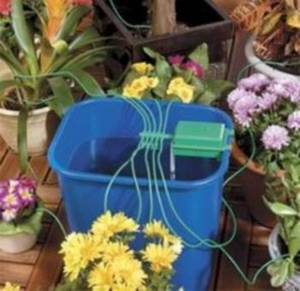
Automatic plant watering system
- The price of an automatic watering system for indoor plants depends on the system configuration and manufacturer.
Video
Watch the video on the topic of the article:
In the past, she was a successful lawyer who radically changed her lifestyle. In the new role of wife and mother, the ability to highlight the main thing and “put everything in order” has remained unchanged. I am always ready to share my discoveries and accumulated experience.
Found a mistake? Select the text with the mouse and click:
Fresh lemon is not only suitable for tea: clean dirt from the surface of an acrylic bath by rubbing with half a cut citrus, or quickly wash the microwave by placing a container of water and lemon slices in it for 8-10 minutes at maximum power. The softened dirt can simply be wiped off with a sponge.
The easiest way to remove scale and carbon deposits from the soleplate of the iron is with table salt. Pour a thick layer of salt onto the paper, heat the iron to maximum and run the iron over the salt bed several times, applying light pressure.
Stretch ceilings made of PVC film can withstand from 70 to 120 liters of water per 1 m2 of their area (depending on the size of the ceiling, the degree of its tension and the quality of the film). So you don’t have to worry about leaks from neighbors above.
The habit of using an automatic washing machine “sparingly” can lead to the appearance of an unpleasant odor in it. Washing at temperatures below 60℃ and short rinses allow fungi and bacteria from dirty clothes to remain on internal surfaces and actively multiply.
The dishwasher cleans more than just plates and cups. You can load it with plastic toys, glass lamp shades and even dirty vegetables, such as potatoes, but only without using detergents.
How to keep house plants while on vacation
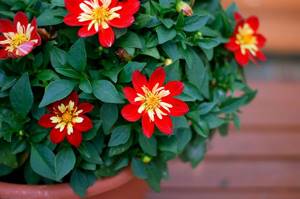
In summer, plants especially need moisture, as strong evaporation occurs. Summer, moreover, is the most favorable season for indoor plants: they grow intensively, flowering occurs, and in the absence or even insufficient watering, the flowers begin to fade. How can you manage with minimal losses in indoor floriculture and at the same time go on vacation?
Experienced gardeners use a number of free measures, thanks to which indoor plants can easily tolerate some time without watering:
- In order to slow down the growth of plants, exclude fertilizing a couple of weeks before departure.
- Conduct an external inspection of plants to exclude diseases and pests. Sick plants are treated with special solutions, and healthy plants are also treated with them for preventive purposes. This is all done 10 days before departure. After 2 days after treatment with solutions, remove all dried leaves and shoots from the plants.
- Before leaving, all flowers are removed without sparing. This is all done so that the plant saves moisture.
- If you grow plants such as tomatoes, herbs, etc. on the windowsill, then if possible, it is better to take them to the country, as their chances of survival increase. Pots with plants can be buried in the ground and sprinkled with sawdust on top, so the soil will retain moisture longer. You also need to choose a suitable location; it is important that the plants are not exposed to direct sunlight all day.

